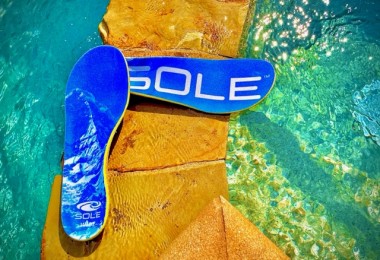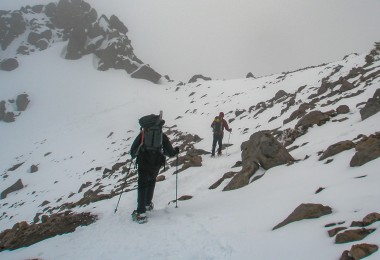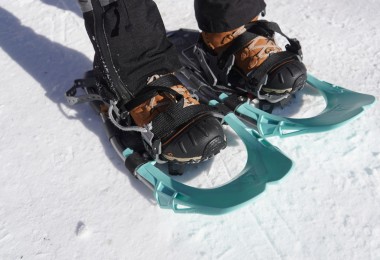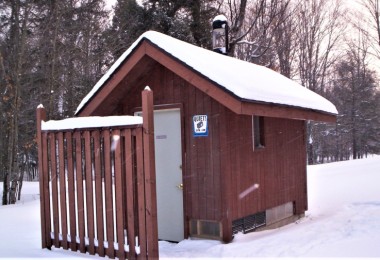Protecting our feet while snowshoeing is critical. A shoe that doesn’t protect our feet can not only ruin our outing and mood, but it can impact our safety in the cold.
But, selecting a shoe to wear for snowshoeing can be confusing since there are so many options available on the market. The good news is that you may not need to buy a brand new pair of boots for your outing and can use a pair you already own. For example, four-season boots or running shoes could work fine for snowshoeing, depending on the weather.
The key is that your snowshoeing footwear keeps your feet warm, dry, and comfortable.
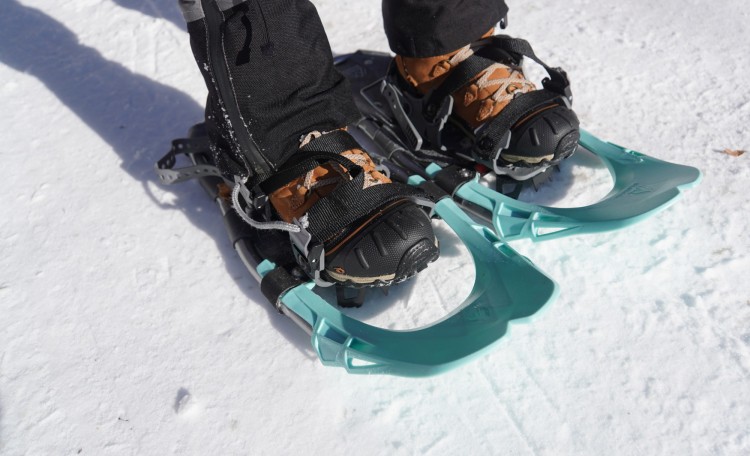
The proper boots or shoes help to protect our feet by keeping them warm, dry, and comfortable. Pictured here are the Women’s Sapphire 8″ Insulated Boots by Oboz. Photo: Paul Wowk
Some of the links in this article may contain affiliate links. When you purchase using these links, part of the proceeds go to Snowshoe Mag at no additional cost. Additionally, as an Amazon Associate, we earn from qualifying purchases. Please see our disclosure for more details.
Footwear Features
The footwear features you look for when snowshoeing have some overlap with those recommended for hiking. Though, there are a few differences. For example, the temperature where you live can make a significant difference in footwear selection, but layering your footwear can help.
Though footwear is a matter of preference, here are a few features to keep in mind for your feet to stay warm, dry, and comfortable.
Waterproof
When looking for new snowshoeing footwear, the first thing is to ensure they are waterproof. Because you’re dealing with snow, wet feet are the last thing you want on an outing. In fact, damp or cold feet can lead to safety concerns.
To avoid wet feet, look for waterproof boots containing membranes that keep water out and let sweat escape. Typically, nylon and synthetic uppers dry faster than leather.
If you don’t have any boots or shoes that are waterproof, you can always treat your current shoes with sprays or waxes (like Nikwax’s Fabric and Leather Proof) to make them more water-resistant
Oboz Bridger Mid Waterproof Hiking Boots
Purchase Men’s at REI | Amazon
Purchase Women’s at Backcountry | Amazon
Muck Boot Tall Arctic Sport and Arctic Adventure
Purchase Men’s Arctic Sport at Amazon
Purchase Women’s Arctic Adventure at Amazon
Read More: 6 Boots for Snowshoeing
Textured Heel
Ensure your shoes have some visible notch or protrusion on the back of the heel where the heel strap of the snowshoe binding can rest so that it does not repeatedly slip off when snowshoeing. Boots with rounded heel areas can sometimes cause the binding to slip (depending on the type of binding).
Merrell Moab 3 Mid Waterproof Hiking Boots
Purchase Men’s at REI | Amazon
Purchase Women’s at REI | Amazon
Men’s Wolverine Polar Range Winter Boot
Purchase at Amazon
Read More: Wolverine Winter Boot Review: Men’s ShiftPlus Polar Range BOA
Tight Lacing
Additionally, check the lacing on the shoe or boot to ensure it stays tight and keeps your foot secure for the duration of your outing. Nothing is more frustrating than having your laces come untied while snowshoeing (we’ve been there). Ideally, the lacing should also be doable with gloves.
Women’s Sorel Joan of Arctic Winter Boot
Purchase at Amazon
LOWA Taurus Pro GTX Mid
Purchase Men’s at REI | LOWA
Purchase Women’s at REI | Backcountry
Read More: Sorel Women’s Boot Review: Tofino vs. Joan of Arctic
Shoe Height
The cut of the shoe (high, mid, low) and level of ankle support is a matter of preference since your snowshoe binding should provide stability and security.
However, if you choose to snowshoe in mid or low-cut hiking boots, it’s recommended to wear gaiters over your boot, so you don’t get snow in your shoes while snowshoeing.
Keen Durand II Mid Waterproof Boot
Purchase Men’s at REI | Amazon
Purchase Women’s at REI | Amazon
Women’s Oboz Sapphire 8″ Insulated Boot
Purchase at Amazon
Read More: Gaiters for Snowshoeing: How To Choose
Traction (or Lack Thereof)
While on your outings, the snowshoe, not your boot or shoe, provides traction.
For this reason, you can use light or winter hiking boots, Canadian leather moccasins, or old running shoes for your snowshoe boots (you no longer need the thick comfortable midsole as the snow is soft). You can even use tennis shoes if you cover or spray them with water-repellent fabric (like Nikwax’s Fabric and Leather Proof).
Jack Wolfskin Terraventure Texapore Mid Hiking Shoe
Purchase Men’s at Dick’s Sporting Goods | Jack Wolfskin
Purchase Women’s at Amazon | Jack Wolfskin
Manitobah Hunter Mukluk
Purchase at Manitobah
Read More: Manitobah: Making Mukluks, Building a Legacy
Lightweight
If possible, try to get by with a light shoe or boot when snowshoeing. Do not negate the advantage you get with a new pair of high-tech and lightweight snowshoes by wearing heavy boots. Snowshoeing is a highly aerobic activity that produces heat. So, the extra insulation provided by some winter boots may not be needed, depending on your body’s temperature and outside temperature.
Instead, think about what would be best to wear if you covered your chosen distance without snowshoes. Except for extreme conditions, footwear that flexes at the ball of the foot is best.
If your feet tend to get cold, solid nylon uppers on the shoe are warmer than mesh. You can also look for Thinsulate, which adds warmth to the shoe or layer your footwear. Each person has different needs regarding heat. So, try to purchase the lightest weight footwear that will suit your specific need but not weigh you down.
Read More: Snowshoeing Dress Code: Tips for What Clothing To Wear
Layer Your Footwear
When choosing your snowshoeing footwear, consider using a larger, half-to-full boot or shoe to accommodate another layer of insulating socks. Tight shoes will restrict circulation and lead to cold feet.
Instead, try to use the layering concept for your feet as you use it with other snowshoe clothing. You want a lightweight and adaptable system for various conditions and uses. You will not need all layers for all situations. To determine what’s best for you, bring layers with you that you add or remove as required depending on your temperature.
Everyone has different metabolic rates, blood flow patterns, and resistance to cold. So you have to pick something that suits you best.
For example, I can use the layers that I need for the intensity, duration, and weather conditions of that day, and it all weighs less and is just as warm as big thick pair of boots on cold days. I currently use the following layers, listed inside to out:
- Pair of thin polypropylene liner socks (like these)
- Water-resistant socks, like those made of neoprene (like these) or merino wool blends (like these) – avoid cotton socks since they will soak in moisture when wet
- Running shoe or light hiking boot
- Stretchy neoprene cycling over bootie
- Gaiter or supergaiter (like this one)
You may not need all these layers, but you can mix and match these as needed.
Read More: 5 Socks for Your Next Snowshoe Outing
Overall
Footwear choice for snowshoeing is truly a matter of preference. However, we shared some features to consider when making your choice, including waterproofing, heel design, tight lacing, shoe height, traction (or lack thereof), and lightweight.
If your shoe has these features or protects your foot by keeping them warm, dry, and comfortable, you may not need to purchase a new pair of boots for snowshoeing. In fact, an old comfortable pair of shoes/boots you already own may work best. Old shoes you already own can require no additional expense. As mentioned, the worn tread should not be an issue since your snowshoe provides traction. Plus, old stretched-out shoes accommodate another pair of socks well and are broken in, so they will flex well in the cold. Finally, the uppers already conform to your feet, and there are probably limited tight spots.
So, what recommendations do you have for choosing your footwear for snowshoeing? What’s your favorite boot or shoe to use? Please let us know in the comments below.
This article was originally published on Dec 12, 2004. It was re-published on Sept 1, 2022, and most recently updated on Sept 27, 2022.
Read Next: Definitive Guide: How To Choose the Perfect Snowshoes for Your Needs

